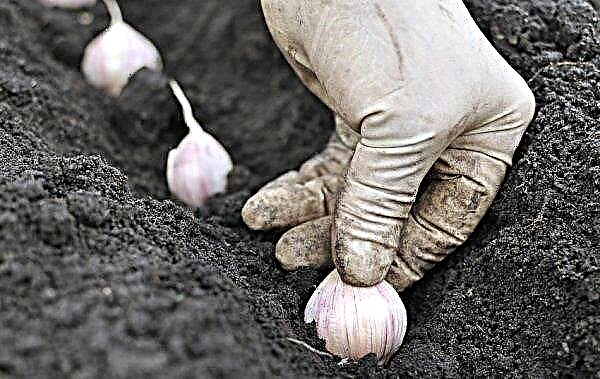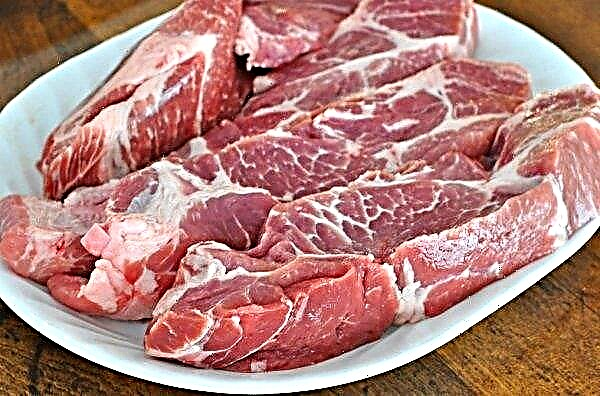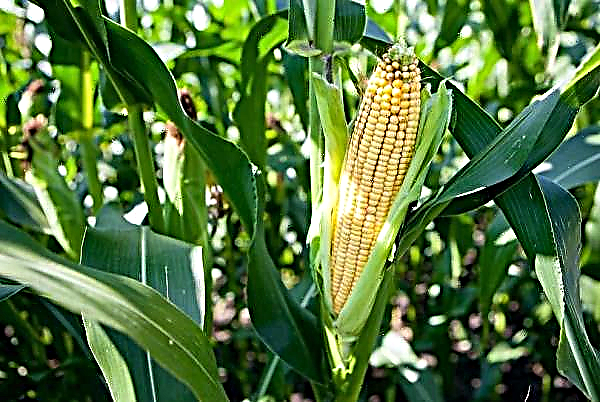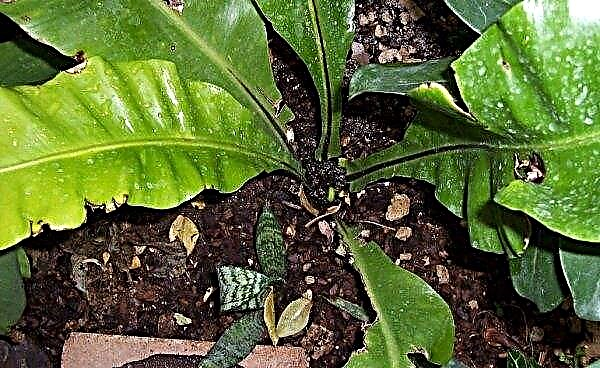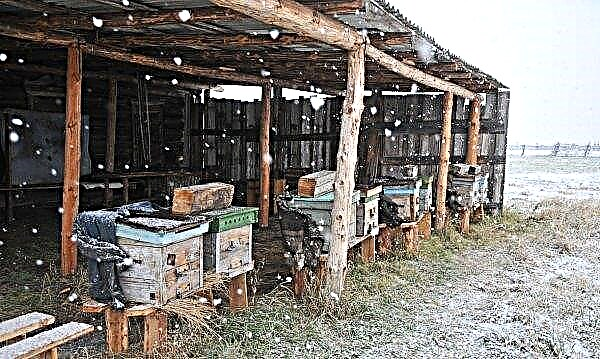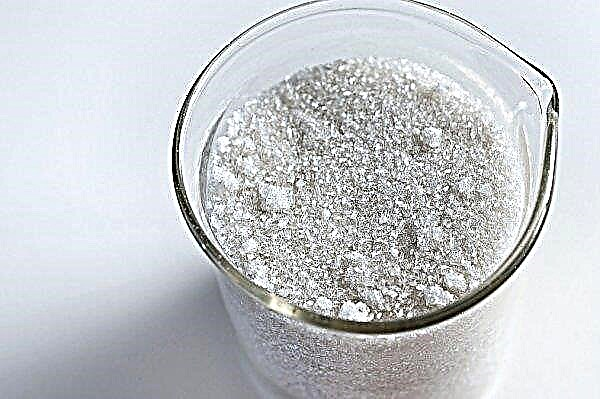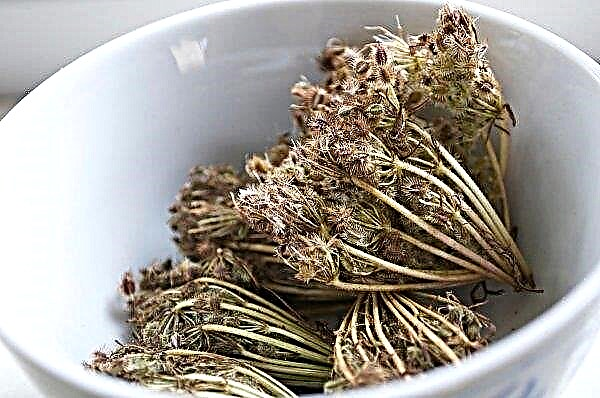Since the time of Peter the Great, potatoes have gradually spread throughout the country and have taken a dominant place in the diet of the inhabitants of Russia. Nowadays, it is grown everywhere, starting from the southernmost regions and ending with the Subpolar region. In this article, we will talk about the Mayak potato variety: its characteristics and description are given, preparation of planting material, planting in open ground and further care of the crop are considered.
History of the variety
Lighthouse potatoes are intended for human consumption. As a result of directed selection, it was obtained by scientists of the Ural Research Institute of Agriculture. In 2013, the variety was included in the Rosreestr. It is recommended for cultivation in the Volga-Vyatka region of Russia.
Did you know? The potato was brought to Europe from America by the Spanish colonialists in the 16th century. Today in the world there are more than 4000 varieties of this vegetable.
Description and characteristic
The considered variety with many tubers and good adaptation to growing conditions and climatic zones. Vegetable growers willingly grow the lighthouse in small private farms. This is a mid-season potato - the complete formation of tubers takes from 75 to 85 days. The bush is tall, with powerful stems, covered with green leaves. The leaves are rounded, have a slightly corrugated surface and a wavy edge. Blooms in large flowers with purple petals.

The plant has well-developed roots. From one bush, 12 to 18 weighty tubers can be tied. Tubers from 97 to 153 are formed on well-fertilized soil. The tubers have a beautiful elongated even shape, covered with dark red skin. The peel is smooth, but sometimes it is slightly rough. The pulp inside the tuber is light yellow. The eyes on the surface of the peel are not depressed, inconspicuous, small.
Potato variety Mayak produces yields from 117 to 393 kg / ha: the better the composition of the soil, the higher the tuber yield. The patent for this variety belongs to the Russian company LLC Agrofirm SeDek, whose representatives claim that its yield can be raised to 450-500 kg / ha.
Video: Potato Variety Lighthouse
More than 90% of the Mayak tubers are salable and sold well in the distribution network. Also, the variety is perfectly stored for a long time: under proper conditions, only 4% of tubers deteriorate.
Potatoes of the Mayak variety taste great, do not boil too much, so it can be used to prepare many culinary dishes, except for mashed potatoes. Chips are prepared from it, fried and boiled in its uniform. On the cut, the flesh of the Lighthouse practically does not change color and does not blacken. Tubers contain up to 17.3% starch.
Did you know? At first, potatoes were considered a dangerous and even poisonous plant, so only the poor consumed its tubers. Today, it is one of the most important crops in the world along with rice, wheat and corn.
The variety is relatively not susceptible to the golden nematode, solanaceae and potato mosaic cancer. The Lighthouse also has medium resistance to late blight, rhizoctonia, scab and plant rot. To grow this potato, you need to choose soils with a deep occurrence of soil water, since it is prone to soaking tubers.
Due to the fact that the variety is very productive, plants require an increased amount of organic matter and mineral fertilizers.

Positive and negative sides of the variety
Potato Lighthouse has excellent nutritional properties. With each serving (100 g) of this steamed vegetable, the human body receives:
- 0 g of cholesterol;
- 17 g of carbohydrates;
- more than 2 g of dietary fiber;
- 2 g of protein;
- a few mg of vitamin A, D, and B12;
- calcium, iron and magnesium.
- Grade advantages:
- stable high productivity;
- marketable large tubers;
- small eyes;
- convenient tuber shape;
- good taste;
- resistance to certain diseases;
- ability to long-term storage without loss.
- Cons of the variety:
- weak friability during cooking;
- low starch content.
Planting potatoes in the open ground
Potatoes are planted in open soil after the earth has warmed well to a depth of 15–20 cm. In order to get good root crop yields, the vegetable grower must make sure that the soil is nutritious, loose and permeable to water and air.

Soil requirements
Without the introduction of organic or mineral fertilizers into the soil, the vegetable grower will not be able to get high yields of root crops. The most successful is the fertilization of the soil with organic substances, such as cattle manure, bird droppings, humus, peat, compost. Organics are introduced immediately before plowing or digging the soil.
Organic fertilizers are laid out in a uniform layer over the future potato field, after which they are embedded in the ground, covering with a layer of soil. Organics can not be placed on the field in advance, since there will be evaporation of its most valuable component - nitrogen. Such fertilizers are used at the rate of 100 kg per hundred square meters of land.

Dates for boarding
Potato planting dates may vary by crop region. For example, in the southern regions of Russia, such as the Krasnodar Territory, potatoes are planted in late March or early April. In central Russia, potatoes are planted in early May.
Did you know? An ancient folk sign for determining the time of planting potatoes is the phase of development of leaves on a birch. If the diameter of the birch leaf exceeds 1 cm, it means that the earth has warmed up enough and it is time to plant potatoes.
Preparing planting material
About a month before the expected date of planting potatoes in open ground, planting material is removed from the store. During this time, the grower warms up and sprouts planting potatoes. For this, potatoes are brought into a heated room with good natural or artificial lighting. Root crops must be decomposed on a flat surface, in no more than two layers.
The most convenient will be the use of plastic fruit crates - they are conveniently placed on top of each other, the bottom and walls do not interfere with the access of light and heat to the potatoes. The height of the stack of boxes with planting potatoes during warming and germination should not exceed five pieces.
 The size of the tubers is the most important physical and technical characteristic of the potato crop.
The size of the tubers is the most important physical and technical characteristic of the potato crop.
The temperature in the room should be maintained in the range of +18 ... + 20 ° C - it is optimal for awakening the eyes on the peel and further development of potato sprouts. Maintaining a hotter temperature in a room with planting material is not recommended, as this will lead to increased growth and thinning of seedlings on potatoes. Overgrown sprouts are not too viable, they break easily and can rot after planting in the ground, especially in insufficiently heated soil. The optimal sprout length on a planting potato ready for planting does not exceed 5 cm.
It is important for the potato grower to ensure that during germination the light enters the entire planting material. To do this, periodically, every 10 days, you need to swap the lower and upper boxes in the stack. During the relocation of boxes with planting material, you need to moisten the potatoes. It is convenient to do this from a manual spray gun for indoor flowers. In this case, you need to use only warm water.
Important! If long and thin etiolated shoots appear during storage in the basement on the planting potatoes, it is recommended to remove them before starting work on heating and germinating planting material.
The treatment of tubers from pests and diseases is carried out before heating and vernalization. This is due to the fact that potato sprouts break off during the procedure.
Rules for applying any substance (protective or stimulating) to the planting material:
- The treatment procedure is carried out on the street, together.
- The processing agent is diluted according to the attached instructions and poured into a pump-action garden sprayer.
- On the ground they spread a plastic sheet and pour a bucket of planting potatoes there.
- Using a sprayer, they process the potatoes, after which they take the cloth around the corners and shake it until the potatoes are mixed.
- Processed potatoes are poured into boxes for heating and vernalization.
Often gardeners process planting material to protect against destruction or damage by pests during the growing season. To do this, apply such chemicals as Prestige, Maxim, Emeto Quantum and many others.
 Before planting seed potatoes, the shoots must be green and strong.
Before planting seed potatoes, the shoots must be green and strong.
These preparations contain active substances that do not allow the bear, wireworm or larvae of the May beetle to damage the pulp of the mother tuber, and the Colorado potato beetle - leaves and stems. Protection of the underground part of the bush is valid for a period of at least two months, the green part will be protected for approximately 30 days.
Potatoes are also treated with biological growth stimulants, such as Epin, Baikal, which contributes to the appearance of healthy thick potato seedlings.
To get good potato yields, the vegetable grower needs to update the planting material every 5 years. Varietal potatoes for planting are purchased at breeding stations or grown independently from sprouts. Potatoes grown from sprouts retain all varietal properties, but remain clean from viruses and diseases.
As a planting material, the most optimal is medium-sized potatoes, since the small contains little moisture and nutrients, and large to plant unprofitable. If the whole planting potato is large, it can be cut into two or three parts, so that the weight of each part is at least 90-100 g, and has 3-4 well-developed eyes.
 After working with each tuber, the knife blade is lowered into a disinfectant solution (1 g of manganese per 1 liter of water)
After working with each tuber, the knife blade is lowered into a disinfectant solution (1 g of manganese per 1 liter of water)
Technology and landing pattern
Potatoes can be planted both in furrows and in ridges. Landing in the ridges is mainly used in the northern regions, where summers are short and not too hot. Potatoes in the crests warm up quickly and enter the vegetation process. For the southern regions, this method is not suitable - in the elevated state, the soil quickly loses moisture and dries up.
In the south and in temperate zones, potatoes are planted in furrows or planting pits. For the manufacture of planting furrows, a marker is used, the tips of which are plows - it is pulled along the future potato field. The depth of the furrow can be from 10 cm and deeper, it also depends on the composition of the soil. On well-warmed, light soils, the depth of the planting furrow can reach 15–20 cm, and on heavy, airtight soils with clay, it should not exceed 10 cm. The crop in question gives good yields on sandy, well-fertilized soils or on chernozem.

When planting Mayak potatoes in furrows, the following scheme is observed:
- The distance between the rows is from 45 cm to 60 cm, a wide row spacing is used for machine processing of a potato field.
- The distance in the row between the bushes is from 25 to 30 cm.
- The depth of the landing furrow is from 10 to 15 cm.
- Potatoes spread in furrows are covered with soil level with the rest of the field.
Important! The surface of the potato field or the beds after planting root crops should not be too leveled, as uneven soil contributes to the retention of moisture.
Planting potatoes in the combs:
- When landing in ridges on the surface of the soil, marker strips are also created, but they are not buried in the soil.
- Between the rows withstand a distance of 50-60 cm, in a row of potatoes are laid out at intervals of 25-30 cm.
- After planting material is spread out over the entire row, a plow deepened in the soil is pulled along the row, thereby filling the potatoes spread on the surface with a soil comb up to a height of 20 cm.
- Sometimes after heavy rains there is a need to update the height of the soil ridges.
- As the bush grows, the height of the ridges increases - usually this procedure is combined with weeding.

Care Features
Care for growing potatoes consists in the timely cultivation of the soil near the plants and irrigation, as well as to prevent the development of weeds. The vegetable grower carefully monitors the development of plants and controls the number of pests on them.
Fertilizer and Watering Frequency
If the soil has not been previously filled with fertilizers, during the growing season, fertilizing the bushes is carried out. Organic or mineral substances are scattered under bushes in the root zone shortly before weeding. During soil treatment, fertilizers are mixed with soil, and after rain, after dissolving, they go directly to the roots of plants. During the growing season, potatoes are fertilized twice: the first fertilizer is carried out before the flowering bushes, the second fertilizing is served to the plants 3 weeks after the first.
In the southern regions, potatoes are grown on artificial irrigation. Without watering in hot conditions, this crop poorly sets root crops. The most successful irrigation method is the use of a drip system. Drip irrigation allows moisture to get directly to the roots of the plant without spreading, and also combine the application of mineral and organic liquid fertilizers with watering. In the south, potatoes need to be watered at least once every 10 days, using at least 2 liters of water per 1 bush.

Weed cleaning
During the growing season, potatoes need to be weeded periodically. Weeding helps to keep the soil under the bushes clean and free of weeds, which draw out some of the nutrients and moisture.
Usually, two procedures are carried out for the entire growing season:
- immediately after the appearance of the first green potato sprouts on the surface of the beds, after the entire potato row is indicated;
- before flowering - usually this weeding is combined with hilling bushes.

Loosening and cleaning the soil from weeds is carried out using a chopper with a wide and sharp blade or a Fokin plane cutter No. 3. On large potato private fields, small walk-behind tractors are used, which greatly facilitates the work of farmers.
After the potato fades, no soil work is done between the rows and under the bushes.. This is due to the fact that by this time the bush becomes tall and lush and soil treatment can damage it. There is also the possibility of damage to the underground stolons by sharp metal blades of garden tools.
Mulching is used on small household potato beds in the southern regions, which avoids overheating of the soil and reduces the need for irrigation. Mulch cover potato aisles. Last year's straw, sawdust of non-deciduous trees, rotten leaves from the garden can be used as organic mulch.
Inorganic mulch can also be used, for example, narrow panels of double-sided non-woven agrofibre (spunbond or other agrotextile). One side of this agrotextile is painted black (it is laid with non-woven material to the soil), and the other is white (facing up). Black coloring of the lower part of the cloth will not allow weed seeds to germinate, and the white-painted side will not allow the soil to overheat.
In autumn, after harvesting, organic mulch can be left on the beds - later it will be planted in the ground, where it will decay, enriching the soil with nitrogen.Agrofibre, used as a mulch of potato spacing, is carefully collected before harvesting, washed in water, dried, rolled up and stored until the next season.

Pest and Disease Control
To prevent the development of diseases, plants are treated with chemicals containing fungicides (Ridomil Gold, Quadrice). The procedure can be combined with the treatment of a potato field from pests.
The most dangerous potato pest is the larvae of the Colorado potato beetle. After hatching, the bushes will need to be treated according to the sheet with one of the insecticides ("Karate", "Aktara", "Stop Beetle"). If the summer is very hot and the eggs laid by the bugs quickly turn into a new generation of actively chewing larvae, then the potato field is repeated one or two more times (if necessary).

Harvest recommendations
Variety harvesting time comes, depending on the region of cultivation, in the middle or at the end of August. Prior to harvesting tubers, preliminary work is carried out on the potato field.
If the potato stalks have not yet dried, they are strong and green, and the tubers in the ground are no longer attached to the stolons and are covered with a dense skin, the grower should mow the tops a week before the expected harvest date. This procedure helps strengthen the skin of potatoes and the concentration of nutrients in the pulp. After the beveled tops have dried, they are collected using a rake and taken out of the field.
To dig root crops, choose a dry and sunny day. During harvesting try not to inflict mechanical damage to the tubers. Harvested crops must be well dried before being lowered into the cellar for storage.
For drying, the potatoes are laid out under the sun for one day, after which they are dried for 10 days under the roof of a canopy or shed. Potatoes ready for storage are sorted, laying aside damaged and rotten tubers, as well as selecting planting material for use next spring.

In the cellar or basement, potatoes are stored in large wooden compartments with a capacity of several dozen buckets, or in plastic fruit crates. Fruit boxes are very convenient for storing potatoes, since each one contains no more than one bucket of root crops, it is convenient to stack them on top of each other. In addition, in fruit crates, the walls and bottom have numerous openings for ventilation, so the potato does not rot.
Potato Mayak has excellent keeping quality - at a storage temperature not exceeding +8 ... + 12 ° C, almost all tubers retain their appearance, juiciness and taste.
Potato variety Mayak is popular among potato growers due to the large number of large tubers under each bush, their beautiful shape and good taste.
Network user reviews
ADVANTAGES: contains a small amount of starch, it is convenient to clean, a universal grade, excellent appearance, good keeping quality and high productivity.
DISADVANTAGES: No
You won’t believe it! We planted a new potato for us. It is called the Lighthouse. The bushes grew solid, with long and thick lashes. The inflorescences are dense, gently lilac. We look at our field, do not take our eyes off! The beauty! And the poet’s soul could not stand it! We decided to try to dig up and find out that, at least, something was born? Dug up. My mother! They planted potatoes, but got a "radish", but large and beautiful. In color, one to one - radish! Both the peel and the flesh. The root crop itself is oval, smooth, shiny, small eyes! Twenty-one pieces were counted. Lying, such cute oval. They laughed a lot from emotion. Quickly boiled and made sure again that they had not lost the grade! Moderately boiled, very tasty. Of course, I understand that there are no comrades for the taste and color. But imagine that you are eating fried mushrooms ... So, the beacon slips into the stomach. The potato, as if, is seasoned with some sauce. I laugh, of course, but really tasty. Try it yourself!

